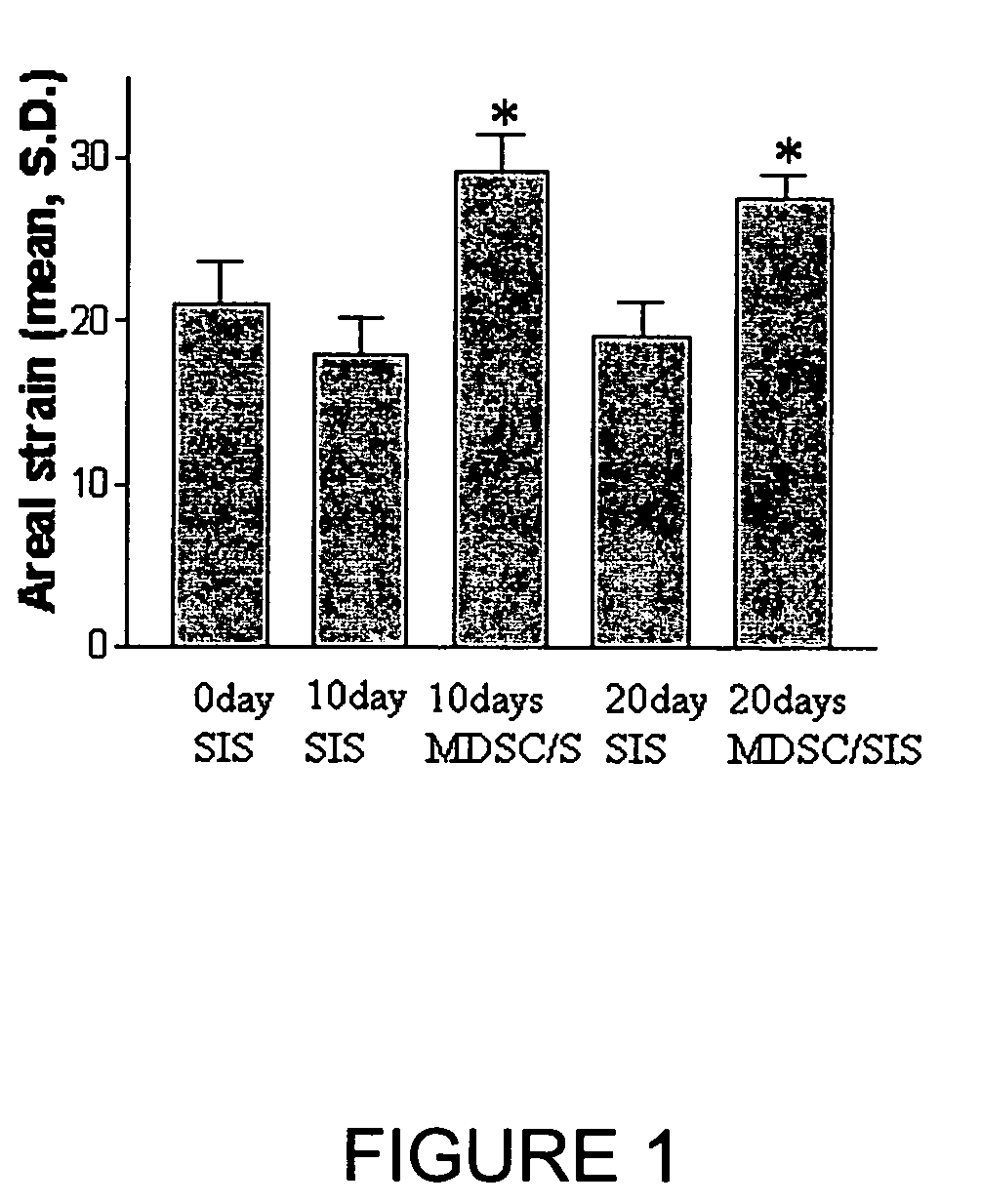Rapid preparation of stem cell matrices for use in tissue and organ treatment and repair
a technology of stem cells and matrices, which is applied in the field of cellular-based tissue engineering, can solve the problems of difficult cell work, high cost and time consumption of cellular-based medical devices, and inability to manufacture cellular-based medical devices, and achieve the effect of improving the sis tissue properties
- Summary
- Abstract
- Description
- Claims
- Application Information
AI Technical Summary
Benefits of technology
Problems solved by technology
Method used
Image
Examples
example 1
Muscle Stem Cell / Alginate Dressing Composition
[0054]Muscle stem cells (MSC) were harvested from rat hindleg muscle using the pre-plate technique (see WO 99 / 56785). After obtaining a late plate (i.e., post PP5, preferably, PP6) cell population, 100,000 cells, transduced with a retrovirus vector containing LacZ, were then suspended in 200 microliters of Hank's Buffered Salt Solution (HBSS; Gibco BRL, Grand Island, N.Y.) for use. A 1 cm2 piece of Alginate (Johnson & Johnson Medical, Arlington, Tex.) was cut, dipped into the MSC suspension to prepare the Alginate+MSC composition and immediately placed on a 1 cm2 full-thickness wound defect on the upper dorsum of rat. After 1 week, the completely healed wound was harvested and stained. The results demonstrated that the Alginate+MSC healed with better cosmesis than did Alginate alone. After a week's time, the wound was completely covered with normal skin. Upon histological examination, the Alginate+MSC, showed better wound closure with ar...
example 2
Muscle Stem Cell / SIS Composition
[0055]Single layer SIS (Cook Biologic, Inc., Indianapolis, Ind.) was initially incubated in Hank's Buffered Salt Solution for one hour at 37° C. 100,000 late preplate (e.g., PP6), (See, WO 99 / 56785; and U.S. Pat. Nos. 6,866,842 and 7,115,417 to M. Chancellor et al.) rat MSC cells (transduced with a retroviral vector containing Lac Z) were placed onto 1 cm diameter circular SIS to form an MSC-SIS matrix composition. The MSC-SIS matrix was placed into a 24-well culture plate. Different preparations of SIS and MSC were then incubated for 3 days, 1 week, and 2 weeks, respectively, to assess cell viability at 37° C., with daily media changes with Dulbecco's Modified Eagle Media (DMEM, Gibco BRL, Grand Island, N.Y.) supplemented to contain 10% horse serum and 10% fetal bovine serum. At appropriate time intervals, the SIS+MSC matrix combination was harvested and sectioned for staining. At all time intervals, cell viability was evident. The MSC continued to p...
example 3
Muscle Stem Cell / Fibrin Glue Composition
[0056]Rat MSC from a late preplate (PP6) were obtained using the pre-plate technique (see, WO 99 / 56785; and U.S. Pat. Nos. 6,866,842 and U.S. Pat. No. 7,115,417 to M. Chancellor et al.). Fibrin glue was obtained from Baxter Healthcare Corporation (Glendale, Calif.). Fibrin glue is an FDA approved sealant that is composed of human thrombin, calcium chloride, bovine fibrinolysis inhibitor solution, and human sealer protein concentrate. The elements are combined prior to use and injected using a needle syringe. Using 100,000 cells and 0.5 cc of fibrin glue simultaneously, the stem cells and fibrin glue were inoculated onto SIS without using barrier inserts. One day later, the system was harvested and sectioned. After immediate placement of fibrin glue and MSC simultaneously on the SIS, not only did the MSC attach to SIS more quickly, but cell viability was maintained. The fibrin glue did not affect the viability of SIS. This experiment showed the...
PUM
| Property | Measurement | Unit |
|---|---|---|
| incubation time | aaaaa | aaaaa |
| incubation time | aaaaa | aaaaa |
| culture time | aaaaa | aaaaa |
Abstract
Description
Claims
Application Information
 Login to View More
Login to View More - R&D
- Intellectual Property
- Life Sciences
- Materials
- Tech Scout
- Unparalleled Data Quality
- Higher Quality Content
- 60% Fewer Hallucinations
Browse by: Latest US Patents, China's latest patents, Technical Efficacy Thesaurus, Application Domain, Technology Topic, Popular Technical Reports.
© 2025 PatSnap. All rights reserved.Legal|Privacy policy|Modern Slavery Act Transparency Statement|Sitemap|About US| Contact US: help@patsnap.com


